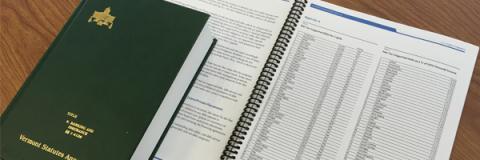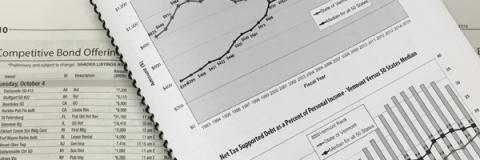Table of Contents
Introduction
Management of the System
Type of Plan and Contributions
Vesting and Membership in the System
Enrollment
Beneficiary Designation
Annual Statement of Benefits
Separation of Service
Termination of Service
Tax on Refunds
Vested Deferred Membership
Transfer of Membership - Portability
Retirement Service Credit
Purchasing Credit
Grant of Service Credit
Military, Legislative or Jury Duty Leave Credits
Approved Leave of Absence
Eligibility for Retirement
Employment After Retirement
Retirement Options
Cost of Living Adjustment (COLA)
Changes in the Monthly Pension Check
Actuary's Report
Other Retirement and Survivorship Benefits
Introduction
The Vermont State Teachers' Retirement System (VSTRS) for Group C members forms a solid foundation for your retirement income. Together with your personal savings and Social Security, you can look to your benefits from the System to help you plan for a secure and comfortable retirement.
Management of the System
The general administration and responsibility for formulating administrative policy and procedures of the retirement System for its members and their beneficiaries is vested in the Board of Trustees consisting of six members. They are the State Treasurer, the Commissioner of Education, the Commissioner of Banking, Insurance, Securities and Health Care Administration, two elected active members, and one appointed retired member.
The Board appoints an executive secretary that acts as executive officer for the Board. The administrative functions of the VSTRS are managed by the Director of Retirement Operations and carried out by the staff. Board meetings are open to the public and members are welcome to attend at any time. Administrative appeals or other claims should be addressed to the Board for action at its next meeting.
Type of Plan and Contributions
VSTRS is a public employee pension plan and trust qualified as a tax-exempt organization under Sections 401(a) if the Internal Revenue Code (IRC). It is a contributory, defined benefit plan to which its participating members make regular contributions to a trust fund and the State of Vermont deposits an annual appropriation (contribution) based on a recommendation resulting from an actuarial assumption of liabilities.
Group C members make annual pre-tax contributions based on pay into the trust fund. Earnings on the trust fund investments provide a portion of your benefit, along with the State of Vermont's contribution.
For current contribution rates, click Here
With a defined benefit plan a participant's actual retirement benefit is specifically determined by a formula, which contains three variables; the participant's service credit, the participants age at retirement, and their average final compensation. The final benefit is not dependent on the amount of contributions made to the plan.
Vesting and Membership in the System
If you were employed as a public school teacher within the State of Vermont on or after July 1, 1990, you are automatically a Group C member. If you were hired before July 1, 1990 and were a group B member in service on July 1, 1990, you are now a Group C member.
You will be vested in the VSTRS upon the attainment of five (5) years of creditable service.
The definition of "Teacher" shall mean any licensed teacher, principal, supervisor, superintendent, or any professional licensed by the Vermont Standards Board for Professional Educators who is regularly employed, or otherwise contracted if following retirement, for the full normal working time for his or her position in a public day school or school district within the State, or in any school or teacher-training institution located within the State, controlled by the State Board of Education, and supported wholly by the State; or in certain public independent schools designated for such purposes by the Board in accordance with section 1935 of this title. In all cases of doubt, the Board shall determine whether any person is a teacher as defined in this chapter. It shall not mean a person who is teaching with an emergency license.
Enrollment
Enrollment is mandatory and you must be enrolled in the VSTRS as soon as you meet the eligibility requirement, previously described, regardless of any probationary period your employer may have. Your employer will notify the system of your employment with their quarterly employment and wage report. You will be sent notification of your enrollment and a designation of beneficiary form, and asked to submit the beneficiary form to the VSTRS as soon as possible.
Beneficiary Designation
A beneficiary(ies) is the person(s) to whom you want your accumulated contributions plus interest to be refunded and/or any available death benefits to be paid to if you die before retirement. However, a death-in-service benefit is only payable to your designated dependent beneficiary.
You may choose any person or your estate, as your beneficiary and you may change your designation at anytime by filing the appropriate form with the VSTRS. All designation of beneficiary forms must be notarized.
If you do not complete a beneficiary designation form, any return of contributions or benefits payable in the event of your death will be payable according to applicable Vermont law.
Annual Statement of Benefits
Each Fall, a computer printed statement is mailed to active members of the system. These statements should be checked over carefully to verify if we have accurate information on the member's account, i.e., date of membership, beneficiary, address, etc. The statement date is as of June 30 of the year sent. The first annual statement would be mailed to a new member in the fall after completion of a full fiscal year of earnings (July 1 - June 30).
The first paragraph explains what a member would receive if they continue working to normal retirement age. The second paragraph explains what a member has earned to date and what a member would receive if they were to terminate their job immediately The statement is calculated based on current salary. All the figures are annual amounts. The third paragraph shows what the member's contributions are to date and the interest that has accrued. This paragraph also shows who is designated as primary beneficiary: if a beneficiary isn't named, ESTATE will appear. If a member has questions regarding the annual statement, they should call our office. It is also very important that addresses are kept up-to-date with the office so that this and other mailings will reach all members.
Separation of Service
If you leave State service before you have acquired five consecutive years of creditable service, and withdraw your accumulated contributions, your service credits will be cancelled. You may leave your contributions in your account for up to six out of seven consecutive years before the VSTRS will automatically withdraw your membership and refund your contribution.
If you separate from service after you have accumulated five or more consecutive years of creditable service, and withdraw your accumulated contributions, your service credits will be cancelled. You may leave your contributions in your account for up to six (6) years before the VSTRS will automatically put your account in a vested deferred status, if you have not returned to service by the seventh year of absence.
Termination of Service
Membership in the retirement system is terminated by the death of a member, retirement of a member or occurs when a member withdraws accumulated contributions regardless of the number of accumulated years of creditable service. For non-vested members, termination of membership will occur when you have been absent from service six (6) years in any period of seven (7) consecutive years.
Tax on Refunds
If a member terminates employment and wishes to take a refund of their contributions plus accumulated interest in lieu of a pension, they are subject to a mandatory 20% federal tax withholding plus a possible 10% excise tax (if the member is under age 59 1/2) on the "taxable portion" of said refund. The taxable portion of a refund is the interest paid by the system on the member's account, plus all employee contributions made on a pre-tax basis. The only way to avoid the 20% mandatory withholding on a withdrawal is to direct the Retirement System to roll over the taxable monies to another tax-sheltered qualified plan. Taxable amounts of less than $200.00 are not subject to the mandatory withholding. This withholding does not apply to pension benefits. This federal regulation became effective January 1, 1993 for all lump sum distributions payable to a member at time of withdrawal.
Vested Deferred Membership
Even if your active membership in the VSTRS ends before you are eligible to retire, you may be entitled to a pension from the VSTRS in the future. Once you have five or more years of service credit, you are vested and cannot lose your credit unless you elect to withdraw your contribution balance.
Transfer of Membership - Portability
Members who leave their employment as a teacher and join either the Vermont State Employees' Retirement System or the Vermont Municipal Employees' Retirement System may transfer their retirement credit to either system within one year of their new employment, and vice versa, provided that they have not received a refund of contributions or any retirement benefit payments.
If a dual membership is established in one of the Vermont Retirement Systems, you will be notified by the retirement office of your option to transfer.
Retirement Service Credit
You will receive one-year of retirement service credit for each year that you are employed as a full-time teacher and are an active member in the System. If you work part-time, you will receive partial credit based on the percentage of the actual number of days that are worked divided by 175 (the equivalent of a full year of service). If you transfer qualified service credit from another plan, it will be included in your accumulated service credit. In addition, you may be eligible to purchase or be granted some types of qualifying service credit.
You will lose your retirement service credit and any retirement benefit if you terminate and withdraw your accumulated contributions. However, if you have five or more years of service and leave your contributions in the System, you are guaranteed a retirement benefit at the normal retirement age of 62, or an early retirement at age 55. All you need to do is contact the retirement office at least nine months before your planned retirement for an estimate and application forms. Retirement benefits are not automatic, you must apply for them.
Purchasing Credit
You may purchase retirement credit for service in the military, Peace Corps, or VISTA (after completion of 15 years of service), service as a state or municipal employee, teaching in another state, teaching in a public or private school, or teaching service with the State of Vermont for which you received no retirement credit.
While the Retirement Office can readily provide you with the actual cost to make the purchase, our experience has shown that acquiring the verification or documentation of prior service can be a lengthy process. To that end, we encourage all members who are interested in following through with a purchase to begin the verification process as soon as possible. Service credit documentation must be reviewed by our office and determined eligible prior to submitting payment. Under the law purchase payments must be completed within a five-year period prior to retirement in equal annual installments. Payments must also indicate whether they are being made on a pre-tax or post-tax basis.
You will need verification of prior service for any of the above categories indicating the years you worked, position held, whether you were full-time or part-time and whether you are eligible to receive a pension associated with the service. Please complete the Application To Purchase Service Credit Form and return it to our office with the verification/documentation of your service. You will also need to indicate the number of years you are interested in purchasing and the timeframe for making the purchase. Upon receipt of this information we will issue a service purchase letter including the eligible years to purchase, the purchase cost, and the time-frames associated with the purchase.
You may also make a contribution to increase the benefit percentage for Group B service before July 1, 1990 from 1.25% to 1.67%.
With at least twenty-five years of creditable service, you also may purchase up to five additional years, called "air time". Air time is non-qualifying time, as opposed to any type of actual service performed. For example, if you have twenty-five years of creditable service, you could purchase the remaining five years of air time and retire with thirty years of service.
All of these purchase opportunities are cost neutral to the system. This means that you must pay the full cost of the added retirement benefit received, including the State's share. Air time cannot exceed five years of creditable service. Total military service also cannot exceed five years. Total purchase for non-military service is limited to ten years of credit, and in no case can a combined total of more than twenty years of service be purchased.
There can be no parallel retirement rights in any other system for the credit you purchase. You should contact the Retirement Office for final cost figures and return on investment information as well as the application procedure.
Important Note: You may make purchases with post-tax dollars or with pre-tax dollars as a direct roll-over from your 403(b), 457, 401(a), 401(k), or IRA account.
Grant of Service Credit
You may be eligible for a grant of service credit in the VSTRS for certain qualifying events. Upon application you may be granted service credit for up to three years of military service in the Korean War and Vietnam Conflict, provided you have 15 years of creditable teaching service. You may also qualify for service credit if during your membership in the VSTRS your employer granted a leave of absence to you for professional study or an exchange program.
Military, Legislative or Jury Duty Leave Credit
If a member is required to take a leave of absence from their present employer to serve in the military, they are entitled to credit in the retirement system for that period of leave if they return to work within 90 days of discharge. If a member takes a leave of absence to serve in the Legislature or on jury duty, or because of a worker comp injury, they are entitled to credit in the retirement system as well. Employers are notified that they must report such leaves to the system, but it is the responsibility of the employee to be sure that the proper credit is made.
For example, if a member takes two weeks of leave without pay for military duty, the service credit that the member receives for that fiscal year may be reduced because of the off-payroll status unless the Retirement Office has received proper notification. The annual statement should always be thoroughly reviewed, and if there appears to be a discrepancy or question about the service credit, the retirement office should be contacted, immediately.
Approved Leave of Absence
After July 1, 1991 if you take an approved leave of absence for purposes other than for professional study, service credit shall be restored upon payment of the contributions that you would have made into the system had you been employed during your absence. In order to be eligible to receive service credit for this period of time, you must submit a copy of a letter from your school or minutes from a meeting of the School Board that permitted the leave of absence and a letter from your school stating what your salary and service credit would have been if you had worked for your full contract that school year. The Retirement Office will review and verify the documentation and provide the cost to restore the service credit.
Eligibility for Retirement
- If on June 30, 2010 you were a member 57 years of age or had at least 25 years of service credit, click here.
- If on June 30, 2010 you were a member less than age 57 with less than 25 years of service credit, click here.
Employment After Retirement
A retired member may generally earn other income without restriction while you are receiving a retirement benefit. However, if they retire and return to work as a teacher or an administrator in Vermont and earn more than 60% of the current average teacher's earnings or work more than the maximum period for substitute teachers; their retirement benefit will be "frozen" and they must return any pension payments and insurance subsidies made to them by the Retirement System in that fiscal year, beginning July 1st and ending June 30th. Please contact the Retirement Office for information on the current allowable earnings for retired teachers. You may contact the Retirement Office for the current allowable earnings for retired teachers.
If they accrue another five (5) years of service credit, they will eligible for an additional retirement benefit based on the new salaries and service credit. When they retire again, both the "frozen" and any new benefits will be paid. Any previous optional election will remain in effect for the "frozen" benefit; they can elect a new option for the additional benefit.
Retirement Options
Option 1 - Maximum
The Maximum Option provides the largest possible benefit payment computed under the Standard Formula to the retiree for his/her lifetime. All payments cease upon the death of the retiree.
Option 2 - Guaranteed Return of Member's Accumulated Contributions
Note: This option is not available to Group B (non-contributory) members. The Guaranteed Return Option provides a slightly reduced payment to the retiree for his/her lifetime with all payments ceasing at the time of the retiree's death. The beneficiary is entitled to receive a cash lump sum payment representing the difference between the retiree's accumulated contributions at retirement (the money contributed to the system by the retiree) and the annuity portion of the retiree's benefit which the retiree has received since the retirement commenced. Generally speaking lump sum contribution balances are exhausted after approximately 10 to 13 years of receiving retirement benefits. The beneficiary designation under this option may be changed subsequently, if the retiree so chooses.
Option 3 - 50% Survivorship Payments to Retiree's Beneficiary/Survivor
This option provides a reduced payment to the retiree for his/her lifetime with the provision that at the time of the retiree's death, one-half or 50% of the retiree's monthly benefit payment continues to his/her beneficiary/survivor for their lifetime. The beneficiary/survivor designated by the retiree at their retirement cannot subsequently be changed. In other words, the continued benefit is not transferable to another beneficiary/survivor.
Option 3-A - 50% Survivorship Pop-Up; see * below
Option 4 - 75% Survivorship Payments to Retiree's Beneficiary/Survivor
Provides a reduced payment to the retiree for his/her lifetime with the provision that at the time of the retiree's death, three-quarters or 75% of the retiree's monthly benefit payment continues to his/her beneficiary/survivor for their lifetime. The beneficiary/survivor designated by the retiree at retirement cannot subsequently be changed. In other words, the continued benefit is not transferable to another beneficiary/survivor.
Option 4-A - 75% Survivorship Pop-Up; see * below
Option 5 - 100% Survivorship Payments to Retiree's Beneficiary/Survivor
Provides a reduced payment to the retiree for his/her lifetime with the provision that at the time of the retiree's death, 100% of the retiree's monthly benefit payment continues to his/her beneficiary/survivor for their lifetime. The beneficiary/survivor designated by the retiree at retirement cannot subsequently be changed. In other words, the continued benefit is not transferable to another beneficiary/survivor.
Option 5-A - 100% Survivorship Pop-Up; see * below
*Options 3A, 4A, and 5A - Survivorship Pop-Ups
These options provide the regular 50%, 75%, or 100% continuation of benefits to the surviving beneficiary with the provision that if the beneficiary/survivor pre-decease the retiree, the benefits to the retiree shall increase to the amount of the retirement allowance which would have been payable under the Maximum Option. If the beneficiary/survivor pre-deceases the retiree, all benefit payments cease upon the retiree's death. Benefits may also revert to Maximum based on the stipulations contained in a plan-approved Domestic Relations Order resulting from a divorce.
Cost of Living Adjustment ( COLA)
Changes in the Monthly Pension Check
It may be necessary from time to time to change tax withholdings, the regular mailing or alternate mailing address, or make changes due to divorce or death. It is the responsibility of the retiree to notify our office in writing of any changes that must be made to your pension check. Changes received by the 15th of any month can be processed for that month. If changes are received after the 15th, we cannot guarantee that the change will occur for that month.
Actuary's Report
The law requires that an approved actuary make an annual valuation of the System's assets and liabilities. The actuarial valuation determines the financial condition of the retirement fund and the required state contribution to the System. The System's consulting actuary also does other special studies related to new or proposed legislation. A copy of the System's current actuarial valuation is available and may be reviewed at the Retirement Office or on the system's website under VSTRS Financial Reports.
Other Retirement and Survivorship Benefits
Health Insurance After Retirement
- If on June 30, 2010 you were a member with at least 10 years of service credit, click here.
- If on June 30, 2010 you were a member with less than 10 years of service credit, click here.
Dental Insurance
At the date of retirement, members are given a one time option to choose Dental Insurance at the full premium cost to the member. Members can also cover all eligible dependents, if applicable. The state will not contribute any portion of this premium. There will be a double deduction for the dental premium from your first pension check, as our office needs to set the payments up in advance of the month during which the coverage occurs.
Social Security
Some retirement systems are integrated with Social Security, and the amount of one's retirement check depends upon the benefit from the federal government. The System has no effect upon Social Security and vice versa; the two supplement one another. Remember that you have to apply for both benefits, since neither is automatic.
Full Social Security is paid at ages 65 to 67, depending on your year of birth. Employees born in 1937 or earlier are entitled to full benefits at age 65; employees born in 1960 or later will be entitled to full benefits at age 67. The full benefit age gradually increases from age 65 to 67 for those born between 1938 to 1959.
Benefits can begin as early as age 62 with a 20% to 30% reduction, depending on your year of birth. The reduction is 20% for employees born in 1937 or earlier.
Single Deposit Investment Account (SDIA)
The single deposit investment account was an option, which was available to members to increase their income at retirement by allowing contributions to be deposited into a tax-sheltered account upon transfer from the non-contributory system. SDIA money is available for withdrawal upon termination of employment or retirement, but a penalty will be applied for withdrawals from the taxable portion prior to age 59 ½, unless retirement occurs after age 55. Please contact Prudential Retirement for distribution information.
If you still have questions regarding your retirement account or other matters about retirement, please do not hesitate to contact the Retirement Office at 1-800-642-3191 (toll free within VT only) or (802) 828-2305. Our staff is always happy to answer your questions and assist in your retirement planning.





